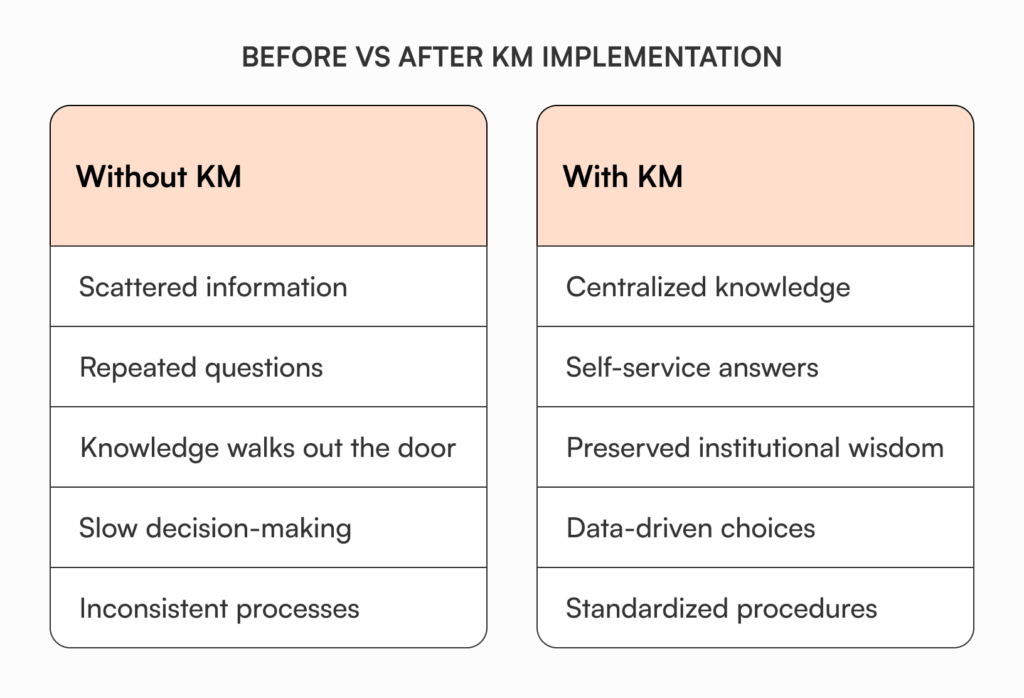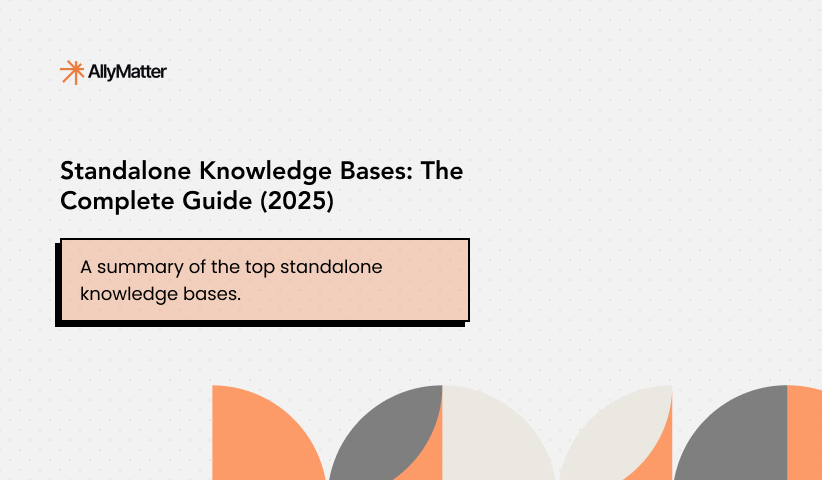Knowledge management refers to the systematic process of identifying, capturing, organizing, and sharing knowledge to enhance productivity and decision-making. As businesses grow and evolve, they generate vast amounts of information, which can quickly become overwhelming if not managed properly.
Effective knowledge management ensures that this information is accessible, structured, and utilized to drive innovation, efficiency, and collaboration. By implementing a knowledge management strategy, organizations can bridge knowledge gaps, retain valuable insights, and create a culture of continuous learning and improvement.
But first, what are the different types of knowledge?
Understanding the different types of knowledge is crucial for building an effective knowledge management strategy. These include:
Explicit knowledge
Explicit knowledge is documented, structured, and easily transferable. For example, it includes manuals, databases, and reports. It is typically stored in digital or physical formats for easy retrieval.
Real-world examples of explicit knowledge:
- The stages of your documented sales process
- Your brand’s content style guide
- Your brand’s content library and its specific content
Tacit knowledge
Tacit knowledge is personal and experience-based, making it difficult to articulate or document. It includes insights, intuition, and skills that individuals develop over time.
Real-world examples of tacit knowledge:
- Recognizing the precise moment when a prospect is open to your sales pitch
- Choosing the perfect language in your copy to capture and connect with your audience
- Determining the ideal content to provide to a customer based on their stated needs
Implicit knowledge
Implicit knowledge is knowledge that is not documented but can be inferred from a person’s actions. Unlike tacit knowledge, implicit knowledge can often be made explicit through documentation and training.
Real-world examples of implicit knowledge:
- Sales negotiation principles: Experienced sales professionals instinctively know how to handle negotiations. They can pick up on client signals, assess their needs, and adjust their tactics seamlessly to secure a deal.
- IT troubleshooting proficiency: IT experts often use their deep, hands-on knowledge to diagnose and resolve intricate technical problems. Their extensive experience and understanding of systems allow them to quickly pinpoint solutions.
- Customer service effectiveness: Customer service representatives build an intuitive understanding of customer emotions, needs, and expectations, enabling them to offer tailored support and smoothly handle difficult situations or upset clients.
Tribal knowledge
Tribal knowledge is informally shared within groups, often passing from one employee to another without formal documentation. It is common in long-established teams and can be a challenge to preserve when employees leave.
Real-world examples of tribal knowledge:
- Problem-solving techniques
- Client interaction protocols
- Operational workarounds
- Cultural nuances
Research from Panopto reveals that 42% of institutional knowledge is unique to individual employees and isn’t documented elsewhere in the organization. This underscores why comprehensive knowledge management strategies must address tribal knowledge capture.

Core components of knowledge management
A successful knowledge management system consists of the following key components:
Knowledge capture
This involves collecting data and information from multiple sources, including employee expertise, customer feedback, and external research. Knowledge capture ensures that valuable insights are recorded before they are lost due to staff turnover or process changes. It includes interviews, surveys, documentation, and knowledge-sharing sessions to store critical information in an organized manner.
- Knowledge storage – Once knowledge is captured, it must be stored systematically for future retrieval. Storage solutions may include databases, cloud-based repositories, or document management systems that allow easy access. An effective knowledge storage system ensures that information is categorized, indexed, and maintained for usability, reducing duplication and improving workflow efficiency.
- Knowledge sharing – Making knowledge accessible is crucial for team collaboration and organizational growth. Sharing knowledge involves using communication platforms, training programs, mentorship, and collaborative tools that help employees exchange information effectively. Encouraging an open culture where employees feel empowered to share their insights can lead to increased innovation and problem-solving capabilities.
- Knowledge application – Capturing and sharing knowledge is only beneficial if it is applied in real-world scenarios. Organizations should establish processes that integrate knowledge into decision-making, strategy development, and operational activities. By ensuring that knowledge is effectively used, companies can improve productivity, streamline processes, and drive competitive advantage.

Knowledge management implementation essentials
Successful knowledge management requires understanding what information to capture and how to organize it effectively:
Critical knowledge categories:
- Company policies and procedures
- Departmental processes and workflows
- Training materials and best practices
- Technical documentation and troubleshooting guides
- Customer insights and service protocols
- Strategic decisions and their rationale
Knowledge management organization principles:
- Structure information by business function and user needs
- Create standardized templates for consistent documentation
- Implement clear categorization and tagging systems
- Establish regular review cycles for content accuracy
Benefits of knowledge management
- Improved decision-making – With a structured knowledge management system, employees can access critical insights and historical data to make informed choices. Having well-organized knowledge reduces uncertainties and enhances decision-making speed and accuracy.
- Increased efficiency and productivity – Employees spend less time searching for information and more time applying their expertise when knowledge is readily available. This leads to faster project completion, reduced redundancy, and streamlined workflows, ultimately enhancing overall productivity.
- Enhanced collaboration and knowledge sharing – A knowledge management system fosters a culture of collaboration by enabling employees to share knowledge across departments and teams. This not only improves teamwork but also ensures that valuable expertise is not siloed within specific individuals or groups.
- Reduced redundancy and knowledge loss – Organizations often face the risk of knowledge loss when employees leave or retire. By capturing and storing knowledge effectively, businesses can retain valuable expertise and minimize disruptions caused by staff turnover.
- Faster onboarding of new employees – A well-structured knowledge management system helps new hires quickly get up to speed by providing them with documented processes, training materials, and best practices. This accelerates their learning curve and enables them to contribute to the organization more effectively.
- Innovation and continuous improvement – By encouraging knowledge sharing and collaboration, organizations can drive innovation. Employees can learn from past experiences, experiment with new ideas, and improve existing processes to maintain a competitive edge in the industry.

Essential knowledge management tools
Several tools can facilitate effective KM, including:
Knowledge base software
A centralized platform for storing and retrieving knowledge, such as FAQs, articles, and manuals, helping employees and customers find information quickly.
Discover the right solution for your needs with the ultimate guide to global knowledge bases.
Wiki software
Collaborative tools that allow employees to create and update knowledge repositories, ensuring real-time knowledge sharing and collaboration.
Document management software
Software that enables the storage, organization, and retrieval of documents, streamlining access to essential information.
Data warehouse software
These tools aggregate and analyze large volumes of data, enabling organizations to derive meaningful insights and make informed decisions.
Project management software
Facilitates knowledge sharing within teams by documenting project progress, discussions, and decisions, ensuring continuity and efficient project execution.
By understanding the types of knowledge, implementing a structured knowledge management process, and leveraging the right tools, businesses can significantly improve efficiency, collaboration, and innovation.
How AllyMatter streamlines your knowledge management approach
AllyMatter provides comprehensive knowledge management solutions designed specifically for growing companies. Our platform transforms scattered information into organized, searchable systems that support effective knowledge capture, storage, and sharing.
With features like granular access controls, intelligent organization tools, and built-in collaboration capabilities, AllyMatter ensures your knowledge management strategy scales seamlessly. The platform supports compliance requirements through detailed audit trails while maintaining the simplicity teams need for daily productivity.
Building sustainable knowledge management practices
Effective knowledge management creates the foundation for sustainable growth, efficient operations, and preserved organizational wisdom. When teams can access the right information quickly and confidently, they focus on creating value rather than hunting for answers. The companies that prioritize knowledge management today build competitive advantages that compound over time.
Ready to implement comprehensive knowledge management that grows with your team? Join our waitlist to discover how AllyMatter’s platform can transform your organization’s approach to knowledge capture, organization, and sharing.
FAQs about knowledge management
How does knowledge management differ from simple document storage?
Knowledge management encompasses the entire lifecycle of information – from capture and organization to sharing and application. Unlike document storage systems, effective knowledge management includes processes for maintaining accuracy, ensuring accessibility, and connecting information to business outcomes.
What’s the biggest challenge in implementing knowledge management?
The primary challenge is creating sustainable processes that employees actually use. According to IDC research, only 45% of employees in large companies with knowledge management systems actively use them. Success requires focusing on user experience and solving real workflow problems.
How do we measure knowledge management ROI?
Track metrics like reduced time spent searching for information, decreased repetitive support requests, faster employee onboarding, and improved decision-making speed. Organizations typically see productivity gains when knowledge management reduces the 20% of time employees spend hunting for information.
Should knowledge management be centralized or distributed?
Effective knowledge management combines centralized governance with distributed content ownership. Subject matter experts maintain their domain knowledge while following organization-wide standards for consistency and accessibility.
How often should we update our knowledge management content?
Establish review schedules based on content type – quarterly for policies, monthly for processes, and ongoing for frequently accessed information. Regular audits ensure your knowledge management system remains valuable and current.


